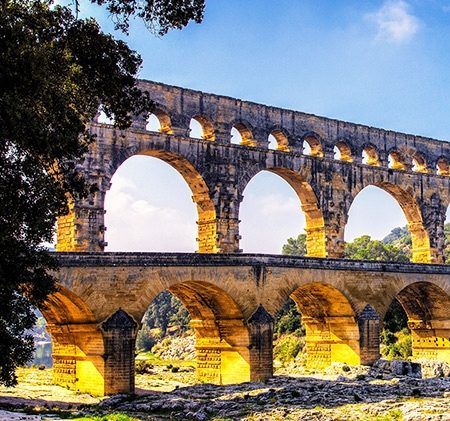Fun Construction News: Researchers Uncover The Secrets of Super-Durable Roman Concrete
The Roman Empire started expanding beyond the Italian peninsula in the 3rd Century B.C. By the second century AD, the Roman empire ranged from Britain’s Atlantic coast to Mesopotamia in the east (the current location of Iraq) and down to North Africa in the south. It is estimated that more than a 20% of the world’s population was under Rome's rule at the peak of the Empire's power.
One legacy left behind from this great Empire are the ruins of many buildings, amphitheaters, roadways, seawalls, sewer systems, bridges, and aqueducts which are now historic sites scattered across Western Europe and other areas formerly under Rome's control. Many people are familiar with the most famous Roman ruins which are now popular tourist spots in Rome, such as the Colosseum (completed in 80 AD) and the Pantheon (completed in 120 AD). However, Roman ruins can been seen from England, down through France, Spain, Portugal, and North Africa, including remnants of an extensive system of roads.
At its peak, the Roman Empire's roadway system included 29 great "military highways" which radiated out from the capital. In addition, the late Empire's 113 provinces were interconnected by 372 "great roads." Overall, the Roman roadway system included more than 250,000 miles of roads, of which more than 50,000 miles were stone-paved.
What is amazing is how well preserved some still-existing Roman structures and sections of Roman roads have remained, despite being built more than 2000 years ago in some cases. In contrast, many modern concrete structures end up crumbling down within just a few decades. This has led many researchers to investigate the secret behind the durability and long life achieved by ancient Roman building materials.
An international team comprised of researchers from MIT, Harvard University, and laboratories located in Italy and Switzerland, have made progress in uncovering some of the key secrets related to the concrete-manufacturing strategies used by Roman builders, including material mixing processes that resulted in important "self-healing" properties. The team published its findings earlier this year in the journal "Science Advances."
For decades, it was assumed that the key to the Roman's ultra-durable concrete was based on the addition of pozzolanic material, such as volcanic ash. However, upon closer examination, samples of Roman concrete also contain small, distinctive bright white mineral features. These white chunks, referred to as “lime clasts,” originate from lime, another key ingredient in the Roman's ancient concrete recipe.
The MIT / Harvard team found that these tiny lime clasts also gave the concrete self-healing properties, which were previously not recognized. By studying samples of the ancient concrete, the researchers found that the white inclusions in Roman concrete were made out of various forms of calcium carbonate. Spectroscopic examination provided clues that the clasts had been formed at extreme temperatures, as would be expected from the exothermic reaction produced by using Calcium Oxide ("quicklime") instead of (or in combination with) "slaked lime" (Calcium Hydroxide). Following this train of investigation, the team concluded that "hot mixing" was actually the key to the super-durable nature of Roman concrete.
During the hot mixing process, the "lime clasts" reportedly develop into brittle structures within the concrete. As soon as tiny cracks start to form within the concrete, the lime clast material begins to react with water seeping into the cracks, creating a calcium-saturated solution. This solution then recrystallizes as calcium carbonate and quickly fills the newly formed cracks. In addition, the solution reportedly reacts with "pozzolanic" materials to further strengthen the concrete.
To help prove their theory, the research team produced two separate samples of hot-mixed concrete: One using the "the ancient formulation" and one using a "modern formulation." After the concrete was fully cured, the team deliberately cracked them and ran water through the cracks. As they had hypothesized: Within two weeks the cracks had completely healed and the water could no longer flow in the hot-mixed "ancient batch" (made with quicklime). An identical chunk of concrete made without quicklime never healed. As a result of this research, the team is reportedly working to commercialize this modified cement material.
For more info, Click Here. For a related Beacon news article (about self-healing concrete), please Click Here.
Please click the image below (Pont du Gard Roman aqueduct, France) for more information and larger photo.
